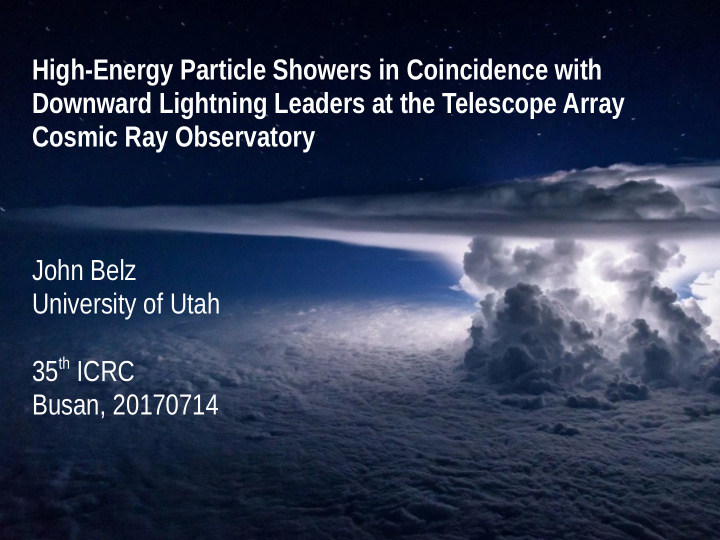



High-Energy Particle Showers in Coincidence with Downward Lightning Leaders at the Telescope Array Cosmic Ray Observatory John Belz University of Utah 35 th ICRC Busan, 20170714
Unknowns In Lightning Production ● “When we consider how much we know about complex and exotic astrophysical objects half way across the universe, it is quite amazing that we do not understand the basics of how something as common as lightning gets started in clouds just a few miles above our heads.” – Dwyer & Uman, Physics Reports (2014) ~3 kV/cm ● Basic Problem: Measured fields consistently too low by an order of magnitude. ● Solutions – Mismeasurement of field? – Initiation from water or ice particles? – Energetic runaway electrons?
Relativistic Runaway Electron Avalanche ● Requires ~MeV seed electrons ● Present due to cosmic rays within 1 µ sec in 100 m sphere at lightning initiation altitudes. (Carlson, 2008) ● Basically always there! ● Are rare effects (e.g. TGFs) due to large RREA–seeding events? GEANT4 Simulation E = 300 kV/m 1 seed electron @ 1 MeV In RREA regime: dT = dz(eE - F f ) ~2 km
Terrestrial Gamma Flashes ● Discovered with BATSE (CGRO) 1992 – Assumed to arise from sprites – Now known to be associated with leader stage in intracloud discharges ● RHESSI (>2002) 805 TGFs ● Fermi Gamma Burst Monitor ● AGILE ● Duration: 100 µ sec → 1 msec ● Flux: 10 14 → 10 19 w/ E > 100 keV. TGF Cartoon (W. Xu dissertation, 2015)
Terrestrial Gamma Flashes ● Discovered with BATSE (CGRO) RHESSI TGFs compared with 1992 RREA models. (Dwyer et al 2005) – Assumed to arise from sprites – Now known to be associated with leader stage in intracloud discharges ● RHESSI (>2002) 805 TGFs ● Fermi Gamma Burst Monitor ● AGILE ● Duration: 100 µ sec → 1 msec ● Flux: 10 14 → 10 19 w/ E > 100 keV. Is there a downward counterpart to this phenomenon?
TA Observation: Plot: T. Okuda “Burst” Events ● 5 year data (2008-2013) ● 10 surface detector bursts seen – 3 or more SD triggers, ∆ t < 1 msec – Occasional ∆ t ~ 10 µ sec ● “Normal” SD trigger rate < 0.01 Hz. These cannot be cosmic ray air showers . ● Found to have close time/space coincidence with U.S. National Lightning Detection Network (NLDN) activity. ● Abbasi et al. Phys. Lett. A 381 (2017).
TA/LMA (“Lightning Mapping Array”) Project : R. Abbasi, J. Belz , M. Byrne, D. Ivanov, R. LeVon, W. Hanlon, P. Krehbiel,T. Okuda, J. Remington, W. Rison, D. Rodeheffer, H. Takai, R. Thomas, G. Thomson and the Telescope Array Collaboration
TA/LMA 10/2013 – Installation ● 10/2013-08/2015 – Unstable operation. ● 08/2015 – Visit, upgrade detector sites ● 08/2015-present – Optimal detector ● 04/2016 – Support awarded by US-NSF ● Atmospheric and Geospace Sciences W. Hanlon (UU), W. Rison (NMTech)
How is Lightning Mapped? VHF Receiver Impulsive radiation Combine to form map Fit to source x,y,z,t (offline)
TA/LMA Event 20160510-024150
TA/LMA Event 20160510-024150 Dashed lines: TASD triggers
20150915-12:13:04 20150915-19:37:01
The “Slow Antenna” ● GPS-timed capacitor, read out with 4 s time Active element; RC ~ 4 seconds constant. ● Record changes in electric field ● vs Electric Field Mill ; measurements of DC Field J. Remington and R. Abbasi (UU)
SD Trigger Burst 20140905
SD Trigger Burst 20140905 (first discharge) Stepped-leader field change Return stroke field change
SD Trigger Burst 20140905 (first discharge)
Are we seeing downward TGFs? TASD: exploded view GEANT4 simulation Cosmic ray core waveform Cosmic ray core waveform Leader-coincident core waveform
Are we seeing downward TGFs? ● Photon absorption length plateaus at few 10's g/cm 2 above ~100 keV. ● ∼100 's of meters @ TA elevations ● Few of the primary photons make it to the ground! ● Simulation study: TASD response to RREA-Photon Spectrum at Altitude ● “Consistent” (term used loosely) with TA observations pdg.lbl.gov
Are we seeing downward TGFs? ● Overall duration of SD bursts comparable to observed TGF ∆ t ● Discrete subevents from few to few 10's of µ sec. ● More to be studied here!
Summary ● TA/LMA in full operation since August 2015. ● Multiple events recorded in which TASD “trigger bursts” are coincident with LMA or slow antenna activity. ● Events consistent with downward Terrestrial Gamma Flashes. ● A significant role for cosmic ray detectors in this field! ● Paper submitted to Geophysical Research Letters; arXiv:1705.06258
Backup
SD “Trigger Bursts”, 2015-2016 ● Okuda criteria; 16 µ s < ∆ t < 1 ms ● 3 bursts found: – 20150915, 12:13:04, VEM = 30, 449, 37, 142, 39 – 20150915, 19:37:01, VEM = 72, 75, 47, 25 – 20160510, 02:41:50, VEM = 105, 109, 4,162, 22,118* ● Full LMA and NLDN information... * saturated FADC
Downward Leaders Followed by Cloud-to-Ground Stroke ● “Leaders” precede main flash. ● Responsible for current- carrying channel which is followed by flash. ● High potential gradients in upward leaders responsible for Terrestrial Gamma Flashes (TGFs) http://www.lightningsafety.noaa.gov/
Downward Leaders Followed by Cloud-to-Ground Stroke ● “Leaders” precede main flash. ● Responsible for current- carrying channel which is followed by flash. ● High potential gradients in upward leaders responsible for Terrestrial Gamma Flashes (TGFs) http://www.lightningsafety.noaa.gov/
TA/LMA Event 20150915-121304
TA/LMA Event 20150915-121304 Dashed lines: TASD triggers
TA/LMA Event 20150915-193701
TA/LMA Event 20150915-193701 Dashed lines: TASD triggers
SD Trigger Burst 20140905 (second discharge) Dart-leader and second return stroke
Recommend
More recommend